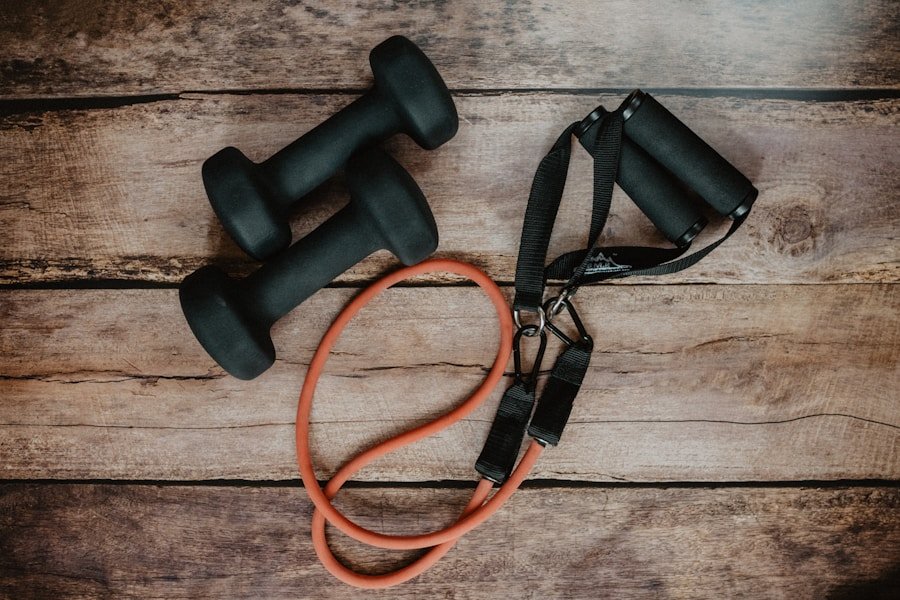When embarking on a fitness journey, it is essential to clearly define and understand your specific objectives. Whether your aim is to lose weight, build muscle, or enhance endurance, having a precise understanding of what you want to achieve is vital. For instance, if your goal is weight loss, you may need to focus on caloric expenditure through cardiovascular exercises and adopt a healthy diet.
Conversely, if your goal is muscle gain, you may need to prioritize strength training and consume a diet rich in protein. Understanding your fitness goals enables you to tailor your workouts to meet your specific needs, ultimately leading to the desired outcomes. Moreover, understanding your fitness goals involves setting realistic expectations about what can be achieved within a specific timeframe.
It is crucial to establish achievable and measurable objectives that can be tracked and adjusted as necessary. For example, if your goal is to lose 20 pounds in three months, it is essential to understand that this may require a combination of regular exercise, a balanced diet, and consistency in your efforts. By understanding your fitness goals and being realistic about what can be achieved, you can set yourself up for success in maximizing your results.
Key Takeaways
- Understanding your fitness goals is crucial for maximizing workout results
- Tailoring workouts to your specific goals can lead to more effective and efficient training
- Customizing your exercise routine based on your goals can help you achieve desired results
- Adapting workouts for weight loss, muscle gain, or endurance can optimize your training
- Incorporating proper nutrition and tracking progress are essential for achieving optimal fitness results
Tailoring Your Workouts to Your Goals
Aligning Your Workouts with Your Fitness Goals
Once you have a clear understanding of your fitness goals, the next step is to tailor your workouts to align with those goals. This involves choosing the right types of exercises and training methods that will help you achieve your desired results.
Choosing the Right Exercises for Your Goals
For example, if your goal is weight loss, incorporating high-intensity interval training (HIIT) or cardio workouts can help you burn calories and shed excess fat. On the other hand, if your goal is muscle gain, focusing on strength training exercises such as weightlifting and resistance training can help you build lean muscle mass.
Considering Frequency and Intensity
In addition to choosing the right types of exercises, it’s also important to consider the frequency and intensity of your workouts. For example, if your goal is endurance, incorporating longer duration workouts at a moderate intensity can help improve your cardiovascular fitness. On the other hand, if your goal is muscle gain, focusing on shorter, more intense workouts with heavier weights can help stimulate muscle growth.
Maximizing the Effectiveness of Your Training
By tailoring your workouts to align with your specific fitness goals, you can maximize the effectiveness of your training and ultimately achieve the results you desire.
Customizing Your Exercise Routine
Customizing your exercise routine involves creating a workout plan that is specifically tailored to your individual needs and preferences. This may involve incorporating a variety of exercises that target different muscle groups, as well as incorporating different types of training modalities such as strength training, cardio, flexibility, and balance exercises. For example, if your goal is overall fitness and well-being, you may want to include a combination of strength training, cardio, and flexibility exercises in your routine.
On the other hand, if your goal is to improve athletic performance, you may want to focus on specific sports-related exercises and drills that mimic the movements and demands of your chosen sport. Furthermore, customizing your exercise routine also involves considering factors such as time constraints, equipment availability, and personal preferences. For example, if you have a busy schedule, incorporating shorter, more intense workouts may be more feasible than longer duration workouts.
Additionally, if you prefer outdoor activities over indoor gym workouts, incorporating activities such as hiking, cycling, or swimming into your routine can help keep you motivated and engaged. By customizing your exercise routine to align with your individual needs and preferences, you can create a plan that is sustainable and enjoyable, ultimately leading to better results in the long run.
Maximizing Results through Targeted Training
| Fitness Goal | Adapted Workout | Key Metrics |
|---|---|---|
| Weight Loss | High-intensity interval training (HIIT), cardio exercises | Calories burned, heart rate, duration |
| Muscle Gain | Strength training, resistance exercises | Weight lifted, sets, reps |
| Endurance | Long-distance running, cycling, swimming | Distance covered, time taken, heart rate |
| Flexibility | Yoga, Pilates, stretching exercises | Range of motion, flexibility tests |
Maximizing results through targeted training involves focusing on specific areas of improvement within your fitness goals. This may involve targeting specific muscle groups for strength training, incorporating interval training for cardiovascular endurance, or focusing on flexibility and mobility for overall functional fitness. For example, if your goal is to improve upper body strength, incorporating exercises such as push-ups, pull-ups, and shoulder presses can help target those specific muscle groups.
On the other hand, if your goal is to improve cardiovascular endurance, incorporating interval training with sprints or high-intensity cardio workouts can help improve your overall stamina. In addition to targeted training for specific areas of improvement, it’s also important to consider the principle of progressive overload. This involves gradually increasing the intensity or volume of your workouts over time to continue challenging your body and stimulating further improvements.
For example, if you have been consistently lifting the same weight for a certain exercise, gradually increasing the weight or number of repetitions can help continue to build strength and muscle mass. By maximizing results through targeted training and progressive overload, you can ensure that you are continually making progress towards your fitness goals.
Adapting Workouts for Weight Loss, Muscle Gain, or Endurance
Adapting workouts for weight loss, muscle gain, or endurance involves tailoring your exercise routine to specifically address the needs of each goal. For weight loss, incorporating a combination of cardio exercises such as running, cycling, or swimming can help burn calories and shed excess fat. Additionally, incorporating strength training exercises can help build lean muscle mass and boost metabolism for long-term weight management.
On the other hand, for muscle gain, focusing on compound exercises such as squats, deadlifts, and bench presses can help stimulate muscle growth and improve overall strength. Furthermore, incorporating a higher protein diet can also support muscle recovery and growth. For improving endurance, incorporating longer duration cardio workouts such as running or cycling at a moderate intensity can help improve cardiovascular fitness and stamina.
Additionally, incorporating interval training with short bursts of high-intensity effort followed by periods of rest can help improve anaerobic capacity and overall endurance. By adapting workouts for weight loss, muscle gain, or endurance, you can ensure that your exercise routine is specifically tailored to meet the needs of your individual fitness goals.
Incorporating Nutrition for Optimal Fitness Results
Weight Loss Goals
For weight loss goals, focusing on a balanced diet that includes lean proteins, complex carbohydrates, healthy fats, and plenty of fruits and vegetables can help support energy levels and promote fat loss. Additionally, staying hydrated by drinking plenty of water throughout the day can help support metabolism and overall health.
Muscle Gain Goals
For muscle gain goals, incorporating a higher protein diet can help support muscle recovery and growth. Additionally, consuming enough calories from a variety of nutrient-dense foods such as lean meats, dairy products, whole grains, and healthy fats can provide the energy needed for intense workouts and muscle building. Furthermore, incorporating pre- and post-workout snacks or meals that include a combination of protein and carbohydrates can help support muscle recovery and replenish glycogen stores.
Endurance Goals
For endurance goals, focusing on a diet that includes a balance of carbohydrates for energy, lean proteins for muscle repair and recovery, and healthy fats for sustained energy can help support overall performance. Additionally, staying hydrated before, during, and after workouts is crucial for maintaining optimal performance and preventing dehydration.
Tracking Progress and Adjusting Your Workout Plan
Tracking progress and adjusting your workout plan is crucial for maximizing results in your fitness journey. This involves regularly monitoring key metrics such as body weight, body composition (muscle mass vs. fat mass), strength levels, cardiovascular endurance, and overall performance in workouts.
By tracking these metrics over time, you can gain valuable insights into how your body is responding to your exercise routine and make necessary adjustments to continue making progress towards your goals. In addition to tracking physical progress, it’s also important to pay attention to how you feel both physically and mentally during workouts and throughout the day. This may involve monitoring energy levels, mood, sleep quality, recovery time between workouts, and overall feelings of well-being.
By paying attention to these subjective measures of progress, you can gain a better understanding of how your body is responding to your exercise routine and make adjustments as needed. Furthermore, adjusting your workout plan may involve making changes to the types of exercises you are doing, the frequency and intensity of your workouts, or even seeking guidance from a fitness professional such as a personal trainer or coach. By regularly tracking progress and adjusting your workout plan based on the feedback from your body and performance metrics, you can ensure that you are continually making progress towards your fitness goals.
In conclusion, maximizing results in your fitness journey involves understanding your specific fitness goals and tailoring your workouts to meet those goals. By customizing your exercise routine to align with your individual needs and preferences and maximizing results through targeted training and progressive overload. Adapting workouts for weight loss, muscle gain or endurance requires tailoring exercise routines specifically for each goal while incorporating nutrition for optimal fitness results involves fueling the body with the right nutrients to support exercise routines and overall health.
Lastly tracking progress regularly will allow adjustments in workout plans based on feedback from body performance metrics ensuring continual progress towards fitness goals.
FAQs
What are the different fitness goals people may have?
Some common fitness goals include weight loss, muscle gain, improved endurance, increased strength, and overall fitness and health.
How can workouts be adapted for specific fitness goals?
Workouts can be adapted by adjusting the type of exercises, the number of sets and repetitions, the amount of weight used, the rest periods, and the overall intensity of the workout.
What are some examples of workouts for specific fitness goals?
For weight loss, high-intensity interval training (HIIT) and cardio workouts are effective. For muscle gain, weightlifting and resistance training are key. For improved endurance, activities like running, cycling, and swimming are beneficial. For increased strength, compound exercises like squats, deadlifts, and bench presses are important.
How important is nutrition in achieving specific fitness goals?
Nutrition plays a crucial role in achieving specific fitness goals. For weight loss, a calorie deficit is necessary. For muscle gain, a diet high in protein is important. For improved endurance and overall fitness, a balanced diet with adequate nutrients is essential.
What role does rest and recovery play in achieving specific fitness goals?
Rest and recovery are crucial for achieving specific fitness goals as they allow the body to repair and grow stronger. Overtraining can lead to injury and hinder progress towards fitness goals.














